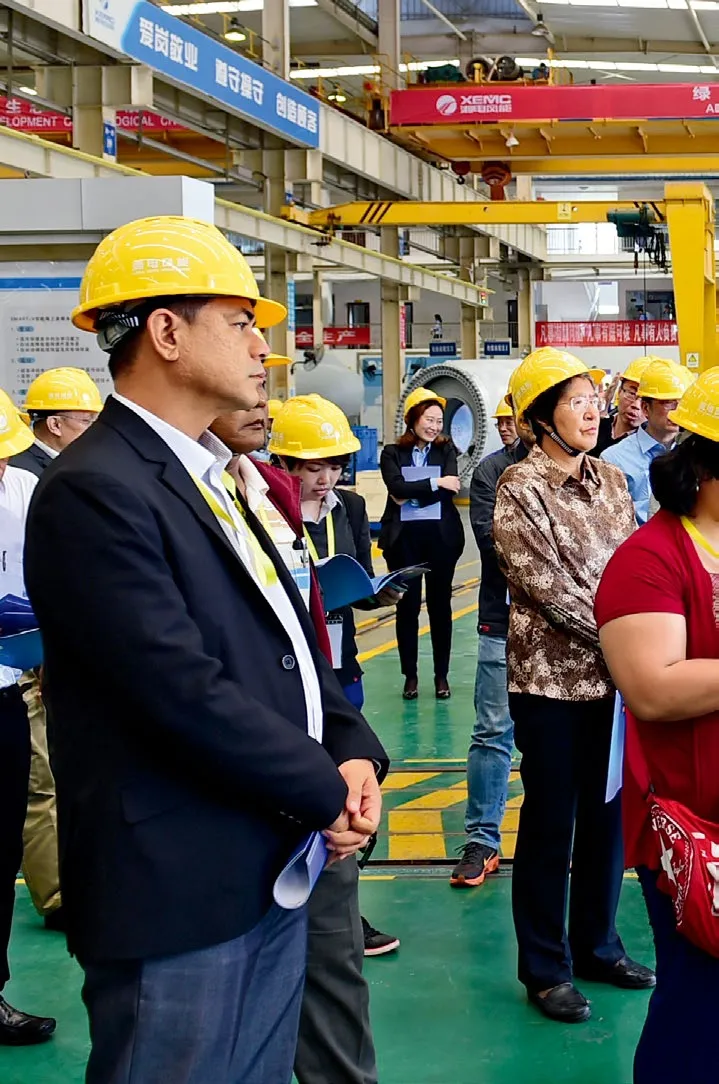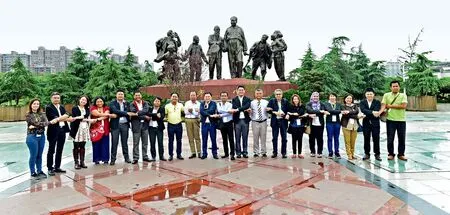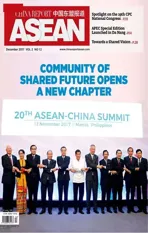SEEING IS BELIEVING
2017-11-22ByZhangYan
By Zhang Yan
ASEAN journalists benefit from first-hand China experience
SEEING IS BELIEVING
By Zhang Yan
ASEAN journalists benefit from first-hand China experience
Beijing, Guangdong,Fujian, Yunnan, Jiangsu,Hunan, Jiangxi....From China’s east coast to inland areas, journalists from ASEAN countries have witnessed China’s development in events known as the China-ASEAN Media Journey on the 21st Century Maritime Silk Road. ASEAN journalists have been joining such events for the past three years. With their journeys, including interviews with local government officials and entrepreneurs,the journalists have gained a better understanding of what China has achieved with the construction of the Belt and Road, particularly the Maritime Silk Road.

ASEAN journalists have traveled the ancient Maritime Silk Road and borne witness to the cultural, economic and social development of the country.

ASEAN journalists link arms in front of a statue of Mao Zedong in Xiangtan,Hunan Province.
Development in the New Era
“Thank you very much for your great hospitality,”wrote Loh Wai Yee, a business journalist with China Press/Malaysia, in the China Report Press visitors’ book. “We are honored to have this opportunity to see and report on the rapid development of China. We would like to do more of this in the future. May ASEAN-China friendship last forever!” Loh came to China in April 2017 with the 3rd China-ASEAN Media Journey on the 21st Century Maritime Silk Road co-hosted by the State Council Information Office of the People’s Republic of China and the ASEAN-China Center, and organized by China Report Press under China International Publishing Group(CIPG).
In these events of the past three years, journalists from nearly 30 mainstream ASEAN media outlets, including Brunei’s Borneo Bulletin,Cambodia’s Khmer Times,Singapore’s Zaobao, Thailand’s Thairath and the broadcast media of the Philippines and Laos, have been invited to visit China, traveling the ancient Maritime Silk Road and bearing witness to the cultural, economic and social development of the country.They visited pilot free trade areas and high-tech enterprises in coastal regions, as well as heavy industrial bases in the hinterlands. They also experienced ancient and traditional culture in addition to the hospitality of the Chinese people.
Over the course of 25 years of dialogue relations, China and ASEAN have become important strategic partners. Bilateral media cooperation such as journeys along the Maritime Silk Road provide ASEAN journalists a fine opportunity to gain a better understanding of the ancient trading route,its modern development and the tremendous changes in contemporary China from an objective and comprehensive perspective. After each journey,many articles and videos were published through newspapers,TV news channels, websites and social media platforms, all of which have shown the world more about China.
“Seeing is believing,”said Maria Lourdes Tiquia, a Manila Times columnist, who was reporting from China for the first time. “The journey has helped us gain a deeper understanding of China in action, as well as the Belt and Road Initiative. China has developed on its own path. It also has its problems and challenges. But China is willing to share with others its experiences and lessons for common improvement and development. I think that is commendable.”


Top: ASEAN journalists visit the Hunan Electric Wind Energy Company in Xiangtan,Hunan Province,on April 20, 2017.
Above: ASEAN journalists at the Just Numerical Control Technology Company in Nanchang,Jiangxi Province,on April 22, 2017.
Media’s Part of Bridge
China and ASEAN member states have laid a good foundation of political trust and economic cooperation.It’s now time for the two sides to expand the scope and means of cooperation to bring more tangible benefits to the peoples of both sides. ASEAN journalists have played the role of a bridge in promoting mutual understanding and exchange.
“When China first proposed the Belt and Road Initiative, many people in ASEAN countries were a little skeptical or afraid,” said Malai Bobby of Borneo Bulletin in an interview an the end of the media journey in April this year. “However, over the last three years, China has done a lot, including economic and trade cooperation,infrastructure construction and cultural exchanges,turning a philosophical concept into reality. China’s actions have helped ASEAN and the world understand that China has been working with its neighbors and the world on a development model of winwin cooperation.”
In the glorious history of the ancient Maritime Silk Road, cultural and peopleto-people exchanges were important factors that promoted interaction between China and the world. Today,culture remains the core and key of communication and mutual understanding.The Belt and Road Initiative upholds the spirit of mutual learning, mutual benefit,interconnectivity, joint contribution and shared benefits. Therefore, it is only natural that countries and cities along the modern Maritime Silk Road give full play to their own advantages and make joint efforts for integrated development.
“It is true that economic and trade cooperation is the most popular area of ASEAN-China cooperation,” commented Noy Kimhong, anchor of National Television of Kampuchea(TVK), who participated in the 2016 Media Journey. “However,I have to say that what really promotes the in-depth development of our relations is culture. I’m very pleased to see increasing bilateral exchanges and cooperation in culture,including student exchanges,art performances and tourism.”
At the same time, ASEAN journalists expressed their hope that an institutional communication platform can be established for information sharing, consultation and coordination with their Chinese counterparts. With the success of the three media journeys, some mainstream ASEAN media outlets have reached cooperation agreements on joint projects with their Chinese counterparts.
“Building the 21st Century Maritime Silk Road is not a solo, but a symphony,” said Yang Xiuping, Secretary-General of the ASEAN-China Center. “China cannot go alone without the active participation of ASEAN member states. The media has a very important part to play.”
Yang noted that media exchanges will cultivate and tap into the cultural connotations of the Belt and Road and enhance the mutual understanding and friendship between the peoples along the route.
